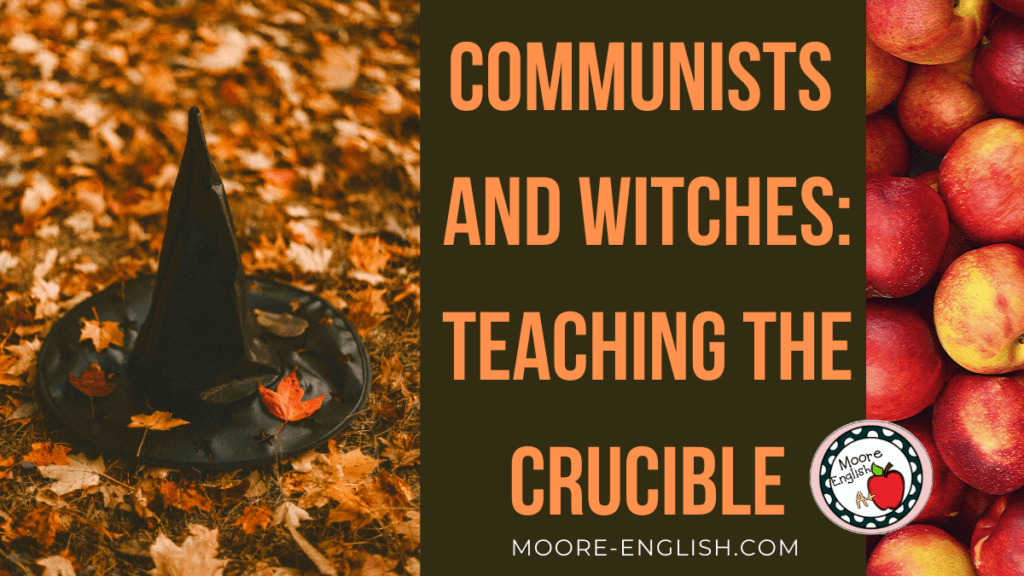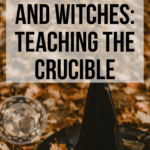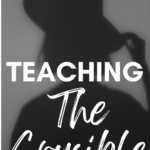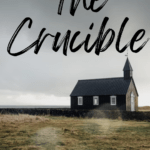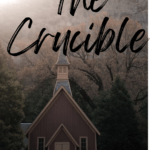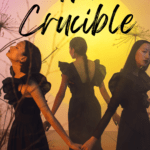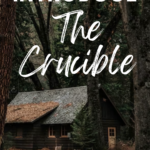My juniors are getting ready to start The Crucible this week, and I am so excited! Arthur Miller’s play is a great way to teach allegory, tone, and speaking and listening skills. It’s also a fun way to end the semester. Here are some of my best strategies and tools for teaching The Crucible:
This post this post may contain affiliate links. Please read the Terms of Use.
Before Reading The Crucible
Over the years, I’ve learned that my students do not need an exhaustive understanding of the play’s historical contexts (yes, that’s plural contexts). However, there is some information students do need to truly understand the text.
–Build context for the Red Scare. For students to truly appreciate The Crucible, they need an idea of the historical context in which Miller wrote the play. To help students build context for the Red Scare, I usually show What is McCarthyism? And How Did it Happen? by Ellen Schrecker on Ted-Ed (one of my favorite Ted-Ed videos!). This short video gives students the basics of McCarthyism and sets up some of the play’s central conflicts. I’ve developed this listening guide to help my students follow along.

–Define allegory. Before discussing the Salem Witch Trials in detail, I introduce the concept of “allegory.” This is a term I define explicitly for students. The definition I use is an author’s use of one event, image, or figure to provide commentary (usually critical and/or political) on another event, image, or figure. Some examples to consider are The Lion, the Witch, and the Wardrobe as Christian allegory or Animal Farm as political allegory. Depending on the class, students often ask me to differentiate allegory from parody, satire, and/or symbolism. When they ask, this is the visual I use.
-Building anticipation and previewing themes. An anticipation guide is another great way to get students excited for reading The Crucible. To preview important conflicts and themes from the play, I use this free anticipation guide!
Visualizing Characters
As I build context for the Red Scare, it’s also important to build context for the Salem Witch Trials and the individuals involved. Here’s how I help students understand the relationships at play in The Crucible.
First, I get a piece of chart paper to post on the board. With my students, I’m going to make a “family tree” of sorts so they can see the relationships between characters in the story. This kind of chart is a must-have anchor chart for secondary ELA. I like to start with Rev. Parris, then go to Tituba, Betty, and Abigail. Once I get to Abigail, I begin to connect all the girls involved in the accusations.
Pro Tip: Even though Ruth Putnam does not speak during the play, adding her to the chart helps students see the relationship between the Putnams and the Salem Witch Trials. As I create the chart on the board, some students will create their own chart, but others will just listen.
Then, I begin to ask for students interested in playing each part. Before class even begins, I might approach students I know who are particularly shy or timid and prepare them for what is coming. Unless a student has an exceptional situation, I require every student to play a part in our classroom “performance.” However, if I know a student gets anxious about speaking in class, I will usually give them a preview of the play’s smaller roles. Then, I will call on them first, so they get a role they feel comfortable with. Similarly, I will also talk to my more outgoing students ahead of time and suggest some of the meaty roles.
Pro Tip: Get a good Danforth. I always remember that I need a good Proctor and a strong Parris, but Danforth slips by me sometimes. Some of his speeches are quite long, so a strong oral reader is a must!
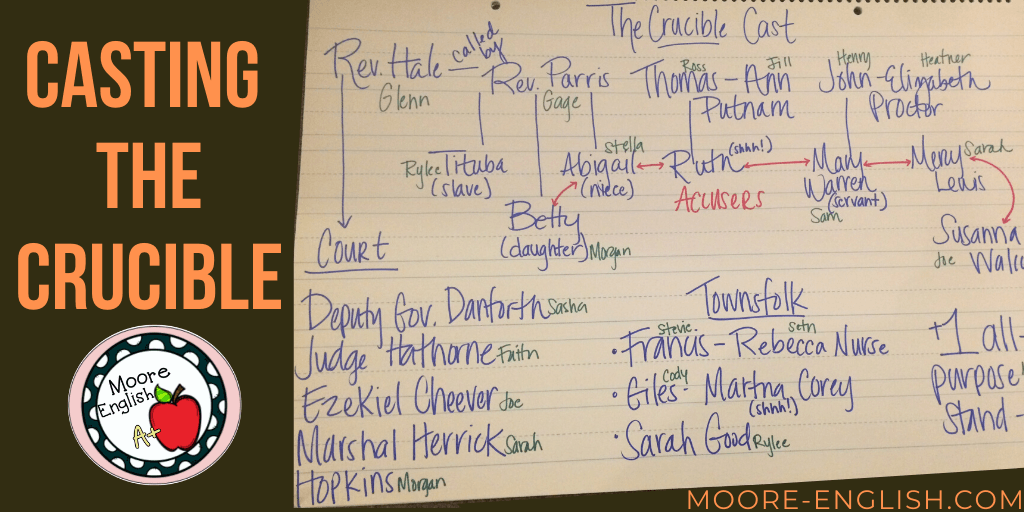
As we cast the play, I add student names to the chart near the character(s) they are playing. I will leave this posted for the duration of the play, so students can continually associate one student with one character. Some students may play more than one character. Some roles that are traditionally female may be not be played by female actors and vice versa, but none of that matters. The goal of casting the play is to help students visualize the text.
Pro Tip: Cast one student as your all-purpose stand-in so when a student is absent, you immediately know who will step up.
Building Context for the Salem Witch Trials
Once I have my cast, I ask my students to do some background reading. I choose background texts from a number of sources, and each student reads a unique article. Very few students will read the same articles. I choose which student will read which piece of background information based on which role(s) the student will have in our play and how well the student reads.
Once students have read their articles, students will work in small groups to create anchor charts with relevant information and visuals. I develop the groups based on what students read and how their readings relate. The groups and readings are listed below. I find groups 1-3 and 6-7 to be especially important. If you are short of students, groups 4-5 could be eliminated. After students have created their anchor charts, they present them to the class, and we hang them throughout the room. I am always impressed by how frequently we reference these charts.
Group 1: The Parris Household The student playing Rev. Parris will read this article from History of Massachusetts, Rebecca Brooks’ historical blog. Our Parris will also read Arthur Miller’s commentary about the character, which begins “At the time of these events…” The article does contain spoilers, so you may want to use a Google Chrome extension like Print Friendly to clip the article accordingly. Similarly, the student playing Betty Parris will read this article, and our Tituba will read this article. Although Abigail Williams is part of the Parris household, too, most articles I have found about her include too many spoilers! If you have a good introductory article about Abigail, let us know in the comments.
Group 2: Rev. Hale and Puritan Religion In this group, the student actor playing Hale will read this article. Additionally, I will assign another student to read the Hale commentary beginning with “Mr. Hale is nearing forty…” This is a dense piece of commentary and requires a capable reader. Then, I divide the rest of Miller’s opening commentary between two students usually having one read from “No one can really know…” and one read from “The believed…” I ask these two students to point out important aspects of Puritan religion, including fear of the forest. The information about Puritan life and religion is dense, so assign these readings to strong readers.
Group 3: Proctor and Putnam In order to set up Putnam and Proctor as parallel characters, I will have a group of only two. Our Putnam actor will read Miller’s commentary beginning with “A word about Thomas Putnam…” The Proctor actor will read Miller’s commentary beginning with “Proctor was a…” Usually, these two students create a t-chart contrasting these two characters.
Group 4: Respected Townspeople This, inevitably, becomes the “Old People Group.” The student actors playing Francis and Rebecca Nurse will read Miller’s commentary beginning with “And while they are so…” This is a good place for students who are capable but not confident readers because they are going to read the same excerpt and can compare notes as needed. I also place our Giles actor in this group. Giles is a great role for a student who is eager to participate but may not be the greatest oral reader. Additionally, Giles is a great role for the class clown. Anyway, the Giles actor will read Miller’s commentary beginning with “Old Giles must be spoken for…”
Group 5: Salem History This group usually takes 2-3 students who are good but not great readers or who maybe lack confidence as readers. Two students can read this article about the Salem Witch Trial victims, or another student can read this article from Smithsonian. Another student can read facts about the Salem Witch Trials. If I need to, our student textbook also includes some background information a student can read. In all cases, read the articles ahead to catch spoilers. Oftentimes, this is the group I ask to present first so they can lay a solid foundation for us.
Group 6: What Options Did the Accused Have? On the surface, this may seem like a silly group. However, I have found this group to be essential because is helps my students understand the limitations of being accused. This group is where I place my lowest readers and my visual readers. For my low readers, this is a good place because Rebecca Brooks’ article is very easy to follow (lots of good text features). Further, all the students in this group are going to read the same article, so they can work together. This is also a good place for my visual learners because the article lends itself to a flow chart. I am almost 100% sure this article contains a spoiler for Giles’ fate, so pre-read and edit ahead of time.
Group 7: Why I Wrote the Crucible by Arthur Miller This is a great place for your Danforth! Typically, my Danforth is a strong independent reader. Miller’s article is an important read but a challenging one, so this is a great place for independent readers. I usually assign 2-3 students to this group and let them know ahead of time that they were specially selected for a challenge. This is usually the group I have present last. Oftentimes, if the students are strong enough, I will also ask them to introduce the idea of an allegory.
While Reading The Crucible
While we read the play, we clear a space in the room to use as a “stage.” Since the play begins with Betty comatose, we use a table as the “bed.” Once we start arranging furniture in the room, students are usually hooked. I’ve written about the importance of acting out plays before, but I will reiterate here that acting out plays helps students visualize the text and the complex relationships between characters.
In particular, while we are reading, students must be actively listening. Over the years, I’ve handled this different ways. Sometimes I use entrance and exits slips to assess how closely students were paying attention. Most of time time, I use student annotations. As a class, students determine what high-quality annotations look like. More often than not, my students determine a number of quality annotations per page of text. Since our summative assessment for this play is a test, I also give formative quizzes after each act.
As we read the play, it’s important to stop and assess understanding (I use these quizzes). After you’ve taught the play a few times, you get an idea of where you need to stop. For example, the Act II scenes with John and Elizabeth are not that exciting, so I frequently ask my students to make inferences based on stage directions. How is their marriage going? How can you tell?
Similarly, Danforth’s speeches in court are quite long, so we may do a close paraphrase of his speeches. Since I still do a bell ringer each day while we’re reading the play, it takes us two or three class periods to read an act. Before we stop for each day, I ask students to make a prediction for tomorrow. Then, at the beginning of the next class period, we begin with those predictions.
Finally, as we read, we return to the students’ anchor charts. In particular, the Putnam and Proctor parallel characters chart becomes more and more important as we begin to consider themes. Similarly, the poster focused on Arthur Miller’s reasons for writing The Crucible becomes increasingly relevant.
Essential Questions for The Crucible
Essential questions are a great way to guide student reading and interpretation of the text. Over the years, I’ve honed in on these 7 essential questions:
- Firstly, what are the characteristics of a successful society?
- Secondly, should religion be part of government?
- How does fear affect the truth and justice?
- When does religion become dangerous?
- What is the source of morality?
- What is the pride of integrity?
- Is gossip harmless?
After Reading The Crucible
While I enjoy teaching The Crucible and its themes do pose still-relevant points for discussion, the text is not without problems. In particular, Miller’s treatment of Tituba and female characters can be troubling. For this reason, reading or discussing the text through critical lenses can be especially important.
- In particular, Tituba is treated poorly in The Crucible. As the only Black character, she is subject to Othering and exoticizing as well as marginalization. For these reasons, a feminist or gender studies lens can shed additional light of Tituba. However, if you really want to undo Miller’s reduction of Tituba, try using the deconstructionist lens.
- For fun! Netflix’s recent The Chilling Adventures of Sabrina frequently alludes to The Crucible. Like The Crucible, Sabrina does not treat all of its Black characters well. For example, check out this article from Teen Vogue about how Sabrina “Failed Prudence Night.”
- Like Tituba (and Taylor Swift), Abigail’s portrayal can have some problems. In particular, reading Abigail’s story alongside Hester Prynne’s story can be revealing. Is Abigail, like Hester, the victim of slut shaming? Consider applying feminist criticism to get a full picture of these characters.
- This article from RealClearPolitics compares The Crucible and contemporary campus assaults. The article, itself, has some problems but also poses some interesting questions for discussion.
- As a tragic hero, John Proctor might also be studied through a critical lens. Is he a tragic hero? A fool? Read more about him here.
Needless to say, I am very excited that my students will begin reading The Crucible next week. The play’s continued relevance amazes me. All my assessment resources for The Crucible are here. What are your favorite strategies for teaching this class play? Let us know in the comments.

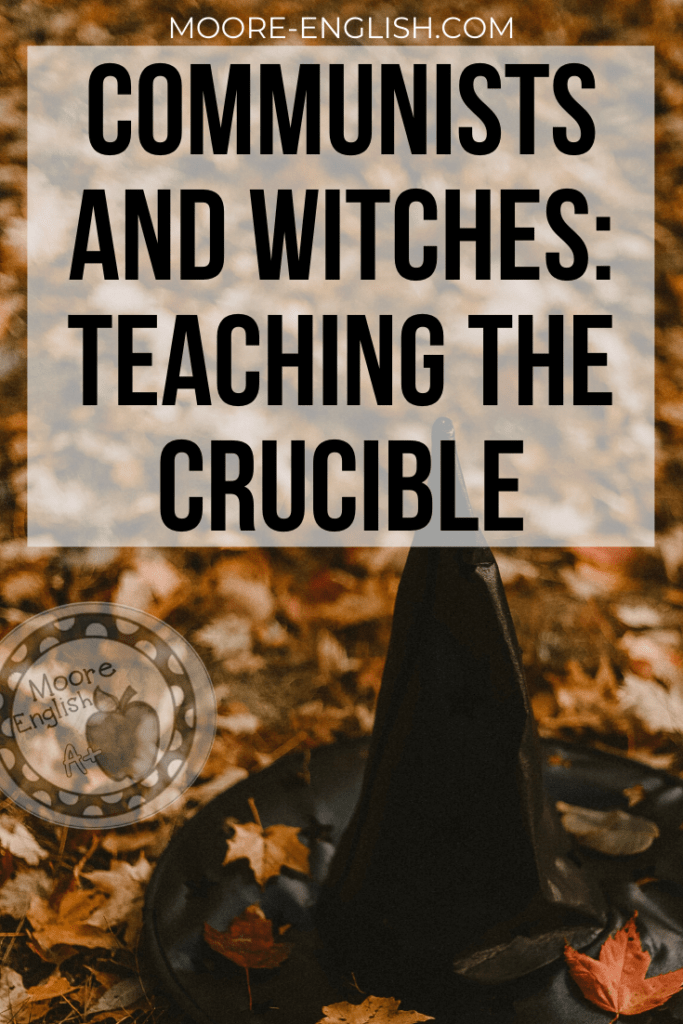
Photo by Rikki Austin on Unsplash

